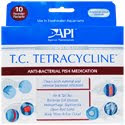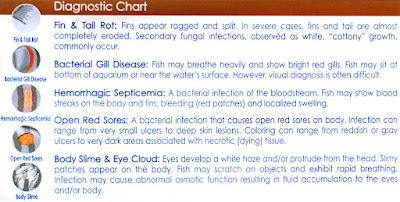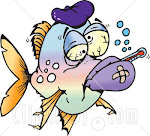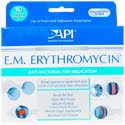Tetracycline; for Fish in Aquarium or Pond
Revised 11/27/21
 Tetracycline Hydrochloride is derived obtained from Streptomyces aureofaciens (and other antibiotics of natural origin) or occasionally synthetically from oxytetracycline.
Tetracycline Hydrochloride is derived obtained from Streptomyces aureofaciens (and other antibiotics of natural origin) or occasionally synthetically from oxytetracycline.
All antibiotics derived from streptomycetes are generally Gram-positive, although Tetracycline Hydrochloride and other antibiotics derived from streptomycetes can have some gram negative activity as well. Also, Tetracycline Hydrochloride is generally more effective for aerobic bacteria
Because it is primarily gram positive, it is generally a poor choice for Columnaris (Flexibacter). Another related antibiotic is Minocyline which can be effective (but still not a first choice for Columnaris though) and it is often confused with Tetracycline Hydrochloride.

Really the only possibly effective Tetracycline product for Columnaris is Doxycycline (which really should be the only Tetracycline product you would use in an aquarium.
Resource: AAP Doxycycline (Fin & Body Cure)
Please Reference: Columnaris in Aquarium Fish
ADVERTISEMENT
 When absorbed, Tetracycline is widely distributed to the organs and tissues of fish. It is eliminated unchanged primarily via the Kidneys and may accumulate with repeated dosing in fish with impaired renal function such as with many cases of Dropsy (which generally makes Tetracycline a poor choice for Dropsy).
When absorbed, Tetracycline is widely distributed to the organs and tissues of fish. It is eliminated unchanged primarily via the Kidneys and may accumulate with repeated dosing in fish with impaired renal function such as with many cases of Dropsy (which generally makes Tetracycline a poor choice for Dropsy).
Tetracycline Hydrochloride mode of action is as a protein synthesis inhibitor via an aminoacyl-tRNA binding mechanism to the 30S subunit. Mode of resistance is the loss of cell wall permeability.
Tetracycline is best used in the treatment of bacterial infections that are gram-positive and SOME gram-negative infections in fish and interferes with the production of proteins that the bacteria need to multiply and divide (bacteriostatic). However many bacterial pathogens have developed resistance to Tetracycline Hydrochloride.
Common uses for Tetracycline Hydrochloride in fish include (generally gram positive causes of these symptoms);
*Streptococcus
*Fin and tail rot (split, ragged and deteriorating fin and/or tail)
*Popeye (protruding eyes, may be cloudy or hazy)
*Gill disease (swollen, discolored gills, gasping for air and a decrease in activity)
*Some secondary infections after treatment of other infections or parasites.
Reference: Gram Positive Streptococcus in Fish
Warnings:
I do not recommend the use of Tetracycline Hydrochloride for bleeding or ulcers in fish as Tetracycline has been shown to cause anemia in fish (and also humans to a lesser degree, which is the last thing you want to do with a bleeding fish.
Tetracycline can lower red blood cell count, because of this I would not use with injured fish. Tetracycline becomes dangerous past its expiration date. While most prescription drugs lose potency after their expiration dates, tetracycline can become toxic over time.
Side effects include: neutropenia (a condition of an abnormally low number of white blood cells), producing a “brown foam” on the surface of the aquarium especially for marine aquariums, and potential destruction of nitrifying bacteria.
s well, Tetracycline Hydrochloride is easily absorbed where calcium is present in larger quantities, which often renders this antibiotic useless in saltwater and high GH (hard water) freshwater aquariums.
The combined use of Tetracycline AND Erythromycin should be avoided (the side effects of these two antibiotics combined will generally negate any benefits obtained when used in combination).
Summary:
Tetracycline Hydrochloride can be a useful antibiotic, especially when others fail, however Tetracycline is more useful in warm blooded animals (humans and Veterinary) than in fish.
USAGE:
Directions from API Tetracycline;
250- 500 mg per 20 gallons of water. Every 48 hours (24 hours for severe issues) with a 25% water change before each treatment. This product will not work in water with a ph above 7.5- NOT FOR MARINE USE! (also not effective in freshwater aquariums with a pH above 7.6)
PRODUCTS CONTAINING TETRACYCLINE OR RELATED ANTIBIOTICS:
*API Tetracycline, for purchase from AAP
*API Doxycycline (Fin & Body Cure), from AAP
Recommended sources to purchase based on extensive aquarium and pond professional experience dating back to 1978.
REFERENCES:
*Aquarium Medications Part 2
*http://en.wikipedia.org/wiki/Streptomyces
*http://ratguide.com/meds/antimicrobial_agents/tetracycline_hydrochloride.php
Further Suggestions:
Prevention of disease is important, please maintain your water chemistry including KH, GH, pH, Ammonia, Nitrites, and even Redox, as all these parameters play a role in disease prevention.
The use of a UV Sterilizer maintained by changing the UV Bulbs every six months can be helpful in prevention (including Redox).
Product Reference Links:
*For UV Sterilizers:
http://www.americanaquariumproducts.com/UVSterilizers.html
*For premium high out put UV Replacement Bulbs:
http://www.americanaquariumproducts.com/UVCReplacementLamp.html
Suggested other aquarium information resources & products:

Fish Diseases | How to Treat Sick Fish
*Aquarium Disease Prevention

Aquarium/Pond UV Sterilizer Use
This article covers many aspects of Aquarium & Pond UV Sterilization from how, why, facts, myths, and maintenance including the importance of changing UV Bulbs regularly.
*Aquarium Lighting
The most up to date and researched article on the subject of aquarium light use for fresh or saltwater aquariums.
*TMC Premium Reverse Osmosis Water Systems for Aquariums

AAP Hydro Sponge Filters
THE PREMIUM Aquarium Sponge Filter with as much as 5 TIMES the bio and mechanical capacity of commonly sold Chinese knock offs!!
Definitely worth the extra $1-3
Labels: API Tetracycline, Fin and tail rot, Gill disease, Streptococcus, Streptomyces aureofaciens, Tetracycline for Fish, Tetracycline Hydrochloride






